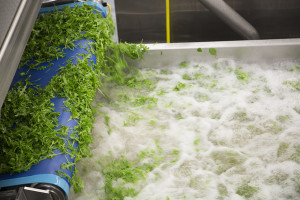Keeping with the pathogen-in-leafy-greens theme of the night, I buy the triple washed and the never washed types of lettuce. My decision is usually based on how much we’ll consume in the next few days. I rinse the not washed. For the triple-washed type I open the bag and consume.
Stephen Kearse of Slate asks, What does “triple-washed” actually mean? And why do salad-green producers brag about washing their lettuce not twice, not four times, but three times in particular?
I initially took my questions to salad-green producers themselves. Of the few companies that responded, most were tight-lipped. “We don’t discuss our business practices,” I was told by the PR director of Trader Joe’s, as if I were a rival firm rather than a customer. “Unfortunately we won’t be able to participate with input for your article,” I was told by the communications director of Dole, as if talking about food were beyond the scope of Dole’s business interests.
Earthbound Farms and Ready Pac were less reserved, offering to take some of my questions and answering them through email, but these exchanges were chillingly mediated, routed through an opaque infrastructure of internal approvals. The answers I received seemed like they had been triple-washed themselves, scrubbed of any negative (or meaningful) content. “From planting to harvest, each stage is inspected and audited to ensure it meets our strict food safety standards,” Earthbound told me. “Ready Pac Foods has long been at the forefront of innovation in safety and quality,” I was told by Ready Pac. I knew when I set out to understand “triple-washed” that I was scratching at the surface of ad copy, but I didn’t expect to find more copy underneath.
Ben Chapman, a food safety specialist and researcher at North Carolina State University, explained that triple washing is at least partially an aesthetic preparation. Triple washing is “not just a food safety step,” he said. “It’s a quality step as well.” The lettuce and other greens that go into our salads are grown in sprawling fields full of soil, rocks, sand, and dust. Because greens are eaten raw, any of these elements could potentially make it onto a plate. The triple-wash process greatly reduces the chance of this happening, removing “dirt, debris, anything you might find associated with the environment when you’re harvesting lettuce,” Chapman informs me. So one of the reasons salad producers love to tout the triple-washed process is that it really does help ensure the purity of greens.
But that doesn’t mean greens that have been cleaned of debris are necessarily free of dangerous microbes. Where the triple-washed label becomes dicey is at the level beyond visual perception. Triple-washed greens aren’t necessarily washed with water—in fact, they’re generally washed with sanitizers and other compounds that are intended to reduce pathogens, according to the food safety literature. But Chapman says these substances only tend to eliminate 90 to 99 percent of the microbes. “Only” may seem like a strange word choice for such a drastic decrease, but in microbiology, effectiveness is measured in log reductions, which are tenfold, meaning that each log reduction decreases bacteria to 10 percent of their initial number. A 90- to 99-percent decrease is only a one- to two-log reduction. Because pathogens can exist in superabundance, on a microbial level, a one- to two-log reduction means that there are still enough remaining pathogens to cause and spread illness.
And even a fourth or fifth wash would not reliably drive that number down, because some pathogens ensconce themselves inside the grooves of leaves like hermit crabs in shells, finding microscopic coves that are unreachable by liquids. Citing a 2007 paper published in Food Protection Trends, Chapman informs me that washing at home actually increases the risk of contamination because surfaces at home are likely crawling with germs. “I can’t do any better with the tools I have at my home than what the processor did. There’s no net risk reduction potential for me to wash. I am literally not doing anything by washing it at home,” he` dryly reports. The only way to amp up that log reduction would be to apply heat, which will produce a supersafe five- to seven-log reduction but also ruin your salad.
So triple washing is a tortured compromise with an inconvenient reality: Salad greens aren’t particularly conducive to consumer safety. From its structural ability to harbor pathogens, to its inability to withstand heat, to its wide surface area, to the fact that it is processed in large volumes (increasing the risk of cross-contamination), commercial lettuce is as outbreak-ready as a 14th-century marmot.
What prevents frequent outbreaks (or rather what can prevent outbreaks) is the system of practices that begin long before the lettuce is washed thrice. There’s a sprawling matrix of voluntary audits, mandated inspections, legislation, certifications, research, services, and training available to ensure that salad is safe before it reaches a consumer or a wash basin. The practices that this matrix targets vary depending on the size of the farm and even the species of greens, but the general questions are straightforward. Are crops segregated from animal pins? Are compromised crops being discarded? Are workers wearing gloves? Are storage facilities regularly cleaned? Are wash waters coming from a safe source? These questions may seem basic, but asking them and acting on them can be the difference between life and death.
Although this matrix is not fail-safe, Chapman insists, it does have the potential to prevent outbreaks, but only when buyers (retailers and consumers alike) look at the practices underlying passed inspections and growers actually apply those practices on days other than inspection day.
